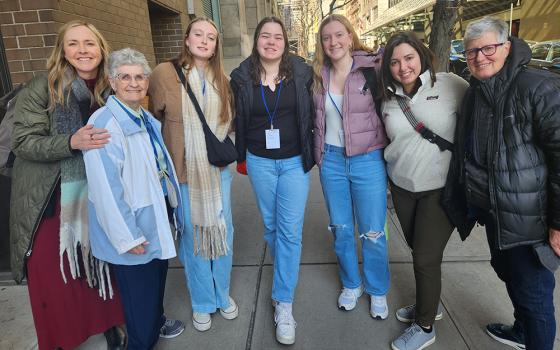Each week, this feature will pose one question to five different newsmakers and analysts. We are continuing with the question asked last week, because both weeks are short. We have heard from Sister Mary Ann Walsh, Director of Media Relations for the USCCB, and from ABC's George Stephanopoulos already. Today, we pose the question to blogger extraordinaire, Rocco Palmo, whose "Whispers in the Loggia" remains one the must-go-to websites in the RC blogosphere.
This week’s question: What is the principal impediment to good media coverage of Catholicism/religion?
Rocco: My short answer to this depends on the day and whatever pops up in the morning’s news. At the same time, though, the red flags all seem to stem from one thing -- how we in the church view (and respect) communication, journalism, and the role of the media in covering things Catholic.
By no means is it universally the case, but far too often, I fear that our communication efforts -- at least, institutionally speaking -- are principally viewed or treated as a function of “message control” and/or rendered tangential, as opposed to something core to our mission which impels us to “keep the light on” and keep our focus on it, regardless of the story of the day. Either way, having worked with hundreds of other journalists over the years, I’ve almost invariably found them to be good, decent, honest people who work hard and take the job’s obligation to fairness and accuracy seriously. By and large, they try to understand the matter at hand as best they can and, so long as it holds up, convey things as we present them. Yet time and again along the way, I’ve likewise discovered the extent to which: 1. they’re fascinated by the church, and 2. they’re looking for all the help they can get in covering us knowledgeably, fairly and with everything the best of the beat deserves. (On a personal note, having been called on to spell “Giovanni Battista Re” by more reporters than I can remember over the last six years, I’m especially grateful that “Marc Ouellet” will make that part of my job considerably easier.)
Much as some of us resort to complaining about the results, we can easily forget that Catholicism is an intimidating topic-area for any secular journalist to tackle, and we need to do a better job of acknowledging the difficulty and, what’s more, easing the anxiety factor (which, on its own, can easily make for mistakes). The NYT’s Rome correspondent, Rachel Donadio, recently said that the Vatican is the toughest assignment she’s ever had, and she’s far from alone in that assessment. So maybe if we just invested more of the energy so quickly and frequently blown on griping into upping the flow and accessibility of information and building more robust relationships, I’d bet we’d end up with better copy. Because just as I’ve yet to see this unbridled sea of all-consuming media bias I’ve heard so much about, I’ve almost always come across a good ocean’s worth of easy misconceptions or questions that, far too often, had never been sufficiently refuted or answered... or, what’s more, things many of my colleagues never even knew about.
One of these is particularly telling: some months back, talking with a full-time religion writer at one of the nation’s preeminent dailies (in a local church whose sizable Catholic population is now majority Latino), I made a passing reference to “Guadalupe” and was about to remark on the intense, all-encompassing devotion the Madonna of Tepeyac holds among many of our newest in the pews.
The word barely left my lips when he stopped me with a question: “What’s Guadalupe?”
As December 12th becomes ever more what March 17th has been for the last century and a half of the American Catholic journey, that the question had to be asked -- not to mention where it came from -- was as astonishing as it is embarrassing for all sides... especially as this guy was beyond well-briefed about what his local ordinary made of his paper’s sex-abuse coverage.
Sad to say, that wasn’t an isolated occurrence, and we have to take at least part of the responsibility that moments like this still happen far more often than they should.
Long story short: when we operate in a culture where far more folks have been “educated” about the Catholic Church by Dan Brown than us, and unwittingly work from the heuristic that comes with it, we have major work on our hands. The success of Brown’s portrayals are by no means the cause of the situation, but a symptom of what we have done in media... that is, what we have failed to do. Yet even this has a sizable silver lining, and anyone who understands that just under the incendiary surface of The DaVinci Code or whatever else of its ilk is powerful proof that this faith and its Founder can still captivate and intrigue the masses would know better than to protest it, but instead, to work to reach this curiosity and invite it anew to our (true) story, told for our time with the same accessibility, energy and conviction that’ve gotten it through a hundred generations and more.
Given the flood of challenges, conceptions and potential storylines, it always helps to make a reporter’s job easy -- more is more, and being able to overload a questioner with those easy but priceless facts and pieces of back-story and context we should have at our reflexive command is worth its weight in gold. Just to offer one example, as the abuse story (and the torrent of popular anger) resurged these last few months, the offering of one simple stat repeatedly changed the tenor I initially found, whether in broadcast or print: that, since 2001 (even before the first tremors in Boston), Pope Benedict had -- both as prefect of the CDF and since his election -- facilitated the permanent removal from ministry of some 2,400 accused clerics worldwide, with the remaining six hundred cases referred to tribunal, most of which have ostensibly returned judgments of guilt (and, invariably, pending whose result one’s initial suspension remained in place throughout).
This wasn’t any sort of speculation or pontifical secret -- the figures were disclosed on-the-record by the CDF’s lead “prosecutor,” Msgr Charles Scicluna. Along the same lines, as early as 1994, Rome upheld the decision of an American bishop to remove a serially abusive cleric who waged a concerted, years-long appeal; this didn’t take place in a conclave, either. Yet time and again, on learning either of these and more, the reporters’ response largely ran along the lines of “Why hadn’t I heard this?” To be fair, the CDF figure was relayed frequently -- albeit buried -- in Stateside coverage when it emerged in mid-March. But in an ecclesial response that should’ve ensured the stat’s easy recollection to memory in the interest of a complete record, its ample and prominent circulation was conspicuous by its absence.
On the other hand, recalling things of the sort doesn’t absolve everything, nor should it -- where they’ve been established, the failures of the record (both abuse itself and the infuriating legacy of cover-up) always need to be immediately, unconditionally admitted, repudiated and repented; this is the irreplaceable sign of the progress and renewal to which we are called, and anything less doesn’t just fail the church’s predominantly uplifting and life-giving work, but to quote the pontiff himself, continues to “obscure the light of the Gospel.” Still, facts which shed light that, even before the earthquake of 2002, the Holy See wasn’t exactly asleep at the wheel and began working at a relatively hasty clip to get up to speed go a long way toward setting the story in a fuller, fairer context, and if we can’t expect management’s own messengers to be on top of providing the tools to make that happen, we can’t exactly cry “unfair,” either.
While we’re at it, the bleeding tends to get short shrift outside media circles, but religion coverage in mainstream news outlets has undergone an especially turbulent decline these last few years in nearly every market. In the wake of massive budgetary and personnel cuts at newspapers across the board, what was once the province of a full-time, well-steeped faith scribe (or even several) often falls these days to any general assignment reporter who’s around. Again, as even the best-schooled of specialized religion journalists have found Catholicism a challenge to cover, this new reality creates a fresh impetus, even a rare, priceless new slate, for us to step up our interaction with newsrooms, to be better prepared to speak not just to the challenges and the heartbreaks, but “to the hope” that’s within us -- and, indeed, to build those effective, mutually respectful, even enjoyable relationships which go a long way toward ensuring not just that the rough stories turn out fair, but helping the good stuff get its moment in the sun, to boot.
Luckily, the obstacles are far from insurmountable -- overcoming them just begins with an open hand and the same spirit of fearlessness, good faith and openness to the other that’s gotten our kind through things far worse than “bad press.” From the beginning, American Catholicism has flourished in large part because we’ve been blessed with the liberty to “bring it” -- and the responsibility to bring the best of it -- into a pluralistic public square brimming with ideas, the fortunes of its speakers determined not by right, but the merit of their argument and the quality of their work. At its zenith, the great Cardinal Gibbons of Baltimore presented a church esteemed by all as the “friend of the people,” and a staunch champion of the institutions which, then as now, make the American experiment possible.
History’s lessons are always useful, and they’re all the more priceless in difficult times -- for starters, they go a long way toward not losing one’s mind. By that standard, we’ve had it way worse; especially in this age of internet publishing, tabloid everything and no shortage of hyper-sensitivity within our walls, we should be appreciative that nothing’s come close to a modern equivalent to The Awful Disclosures of Maria Monk -- the best-selling 1830s “memoir” of a purported former nun claiming to take readers into the life of a convent... one that just so happened to contain every bogus “practice” that fueled the anti-Catholic hysteria of the Nativists who’d spend much of the next decade burning convents and churches in the Northeast.
Even if its success spawned sequels, neither the tawdry novella nor the Nativist torches succeeded at their task, and today’s challenges from outside pale in comparison. Looking narrowly, things might seem tough now, but we can never forget nor discount that we’re the heirs of a people who courageously, selflessly endured generations of suspicion and persecution that we might know the blessing of a fuller freedom.
History tells us they did their part to the hilt... and the more we live up to ours, the more its first draft will say the same of us.
Tomorrow: NPR's Michel Martin, host of "Tell Me More."



